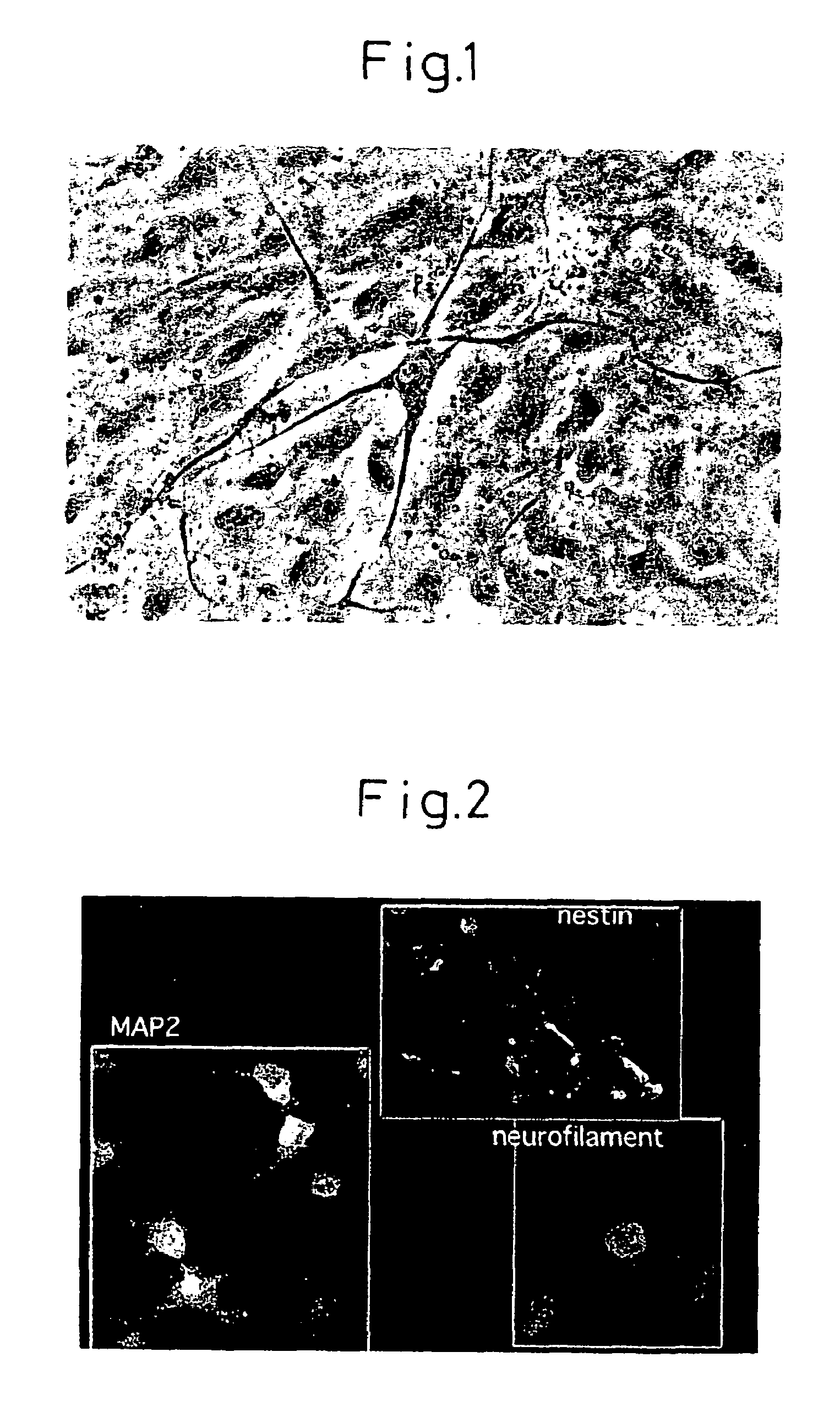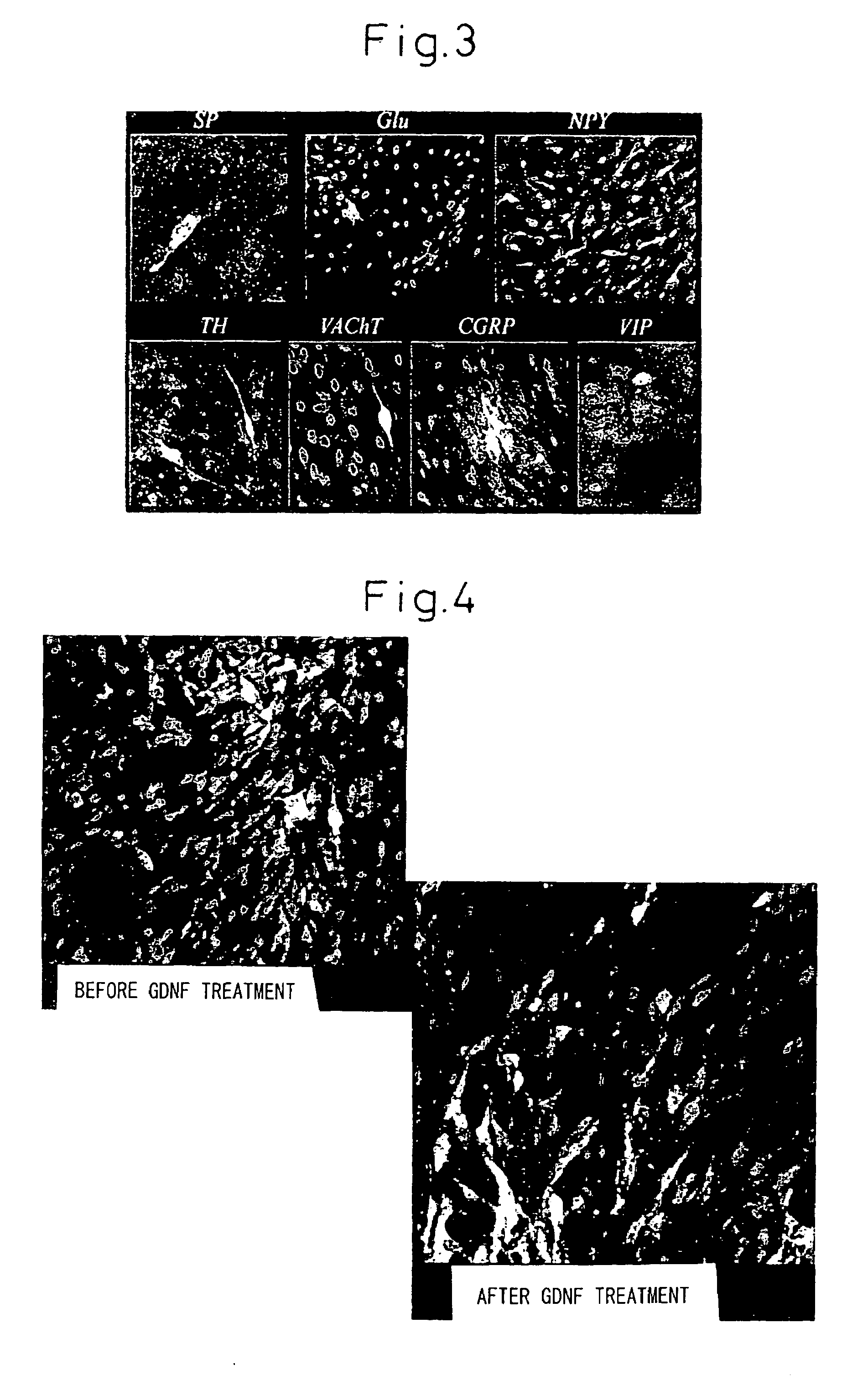Differentiation of bone marrow stromal cells to neural cells or skeletal muscle cells by introduction of notch gene
a technology of bone marrow stromal cells and notch gene, which is applied in the direction of genetically modified cells, skeletal/connective tissue cells, drug compositions, etc., can solve the problems of teratoid tumor risk, major hurdles to human application, and impeding the stable application of this technology
- Summary
- Abstract
- Description
- Claims
- Application Information
AI Technical Summary
Benefits of technology
Problems solved by technology
Method used
Image
Examples
example 1
Neural Induction
[0129]Stromal cells were extracted from the bone marrow of adult rats (Wistar rats) and cultured. The medium used was Minimum Essential Medium Alpha Eagle Modification (M4526, Sigma Co.) containing 20% fetal bovine serum (14-501F, Lot #61-1012, Biowhittaker Co.).
[0130]After subculturing to four generations, the gene for the Notch intracellular domain was introduced when the cells reached 80-90% confluence. A 3.1 kb EcoRI-XbaI fragment of the Notch intracellular domain was inserted at the EcoRI-XbaI multicloning site of pCI-neo mammal expression vector (#E1841) by Promega for recombination. A LipofectAMINE 2000 (11668-027, Gibco BRL) system was used for the introduction.
[0131]On the day following introduction, G418 sulfate (83-5027, Gibco BRL) was added to a concentration of 200 ng / ml and introduced cells were selected for 10 days.
[0132]After restoration of the cell population to 90% confluence, 5 μM of forskolin (344273, Calbiochem), 10 ng / ml of basic fibroblast grow...
example 2
Induction of Dopaminergic Neurons
[0136]The differentiation-induced neural cells were then cultured in Minimum Essential Medium Alpha Eagle Modification (M4526, Sigma Co.) containing 10% fetal bovine serum (14-501F, Lot #61-1012, Biowhittaker Co.), with further addition of 50 ng / ml of glial derived neurotrophic factor (GDNF) (human recombinant GDNF, #450-10, Peprotech EC Ltd.), 5 μM of forskolin (344273, Calbiochem), 10 ng / ml of basic fibroblast growth factor (100-18B, Peprotech EC, Ltd.) and 5 ng / ml of platelet-derived growth factor-AA (396-HB, Peprotech EC Ltd.).
[0137]As a result of this procedure, the dopaminergic neurons exhibiting reaction for tyrosine hydroxylase increased dramatically to 17.2±5.1% of the total neural cells (see right of graph in FIG. 5). As shown in the photograph of FIG. 4, the proportion of tyrosine hydroxylase protein stained green with FIPC increased dramatically after GDNF treatment.
example 3
Induction of Acetylcholinergic Neurons
[0138]The differentiation-induced neural cells of Example 1 were cultured in Minimum Essential Medium Alpha Eagle Modification (M4526, Sigma Co.) containing 10% fetal bovine serum (14-501F, Lot #61-1012, BioWhittaker Co.), with further addition of nerve growth factor (2.5 S NGF, #T002A, Takara), 5 μM of forskolin (344273, Calbiochem), 10 ng / ml of basic fibroblast growth factor (100-18B, Peprotech EC, Ltd.) and 5 ng / ml of platelet-derived growth factor-AA (396-HB, Peprotech EC Ltd.).
[0139]As a result of this procedure, the acetylcholinergic neurons exhibiting reaction for vesicular acetylcholine transporter increased dramatically to 20.5±0.05% of the total neural cells (see right of graph in FIG. 7). As shown in the photograph of FIG. 6, the proportion of vesicular acetylcholine transporter protein stained green with FIPC increased dramatically after NGF (neurotrophin (NTS) treatment.
PUM
| Property | Measurement | Unit |
|---|---|---|
| concentration | aaaaa | aaaaa |
| concentration | aaaaa | aaaaa |
| concentration | aaaaa | aaaaa |
Abstract
Description
Claims
Application Information
 Login to View More
Login to View More - R&D
- Intellectual Property
- Life Sciences
- Materials
- Tech Scout
- Unparalleled Data Quality
- Higher Quality Content
- 60% Fewer Hallucinations
Browse by: Latest US Patents, China's latest patents, Technical Efficacy Thesaurus, Application Domain, Technology Topic, Popular Technical Reports.
© 2025 PatSnap. All rights reserved.Legal|Privacy policy|Modern Slavery Act Transparency Statement|Sitemap|About US| Contact US: help@patsnap.com



